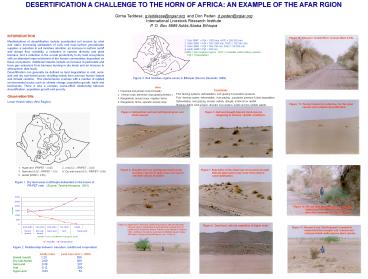1. Hyperarid PRPET 0.02 - PowerPoint PPT Presentation
1 / 1
Title:
1. Hyperarid PRPET 0.02
Description:
Figure 1. Dry land areas in Ethiopia delineated on the bases of PR/PET ratio. ... 3. Xeric SMR = Ppt = 300-700 mm, AWC = 50-198 mm. 4. Aridic SMR = Ppt 300 mm, ... – PowerPoint PPT presentation
Number of Views:67
Avg rating:3.0/5.0
Title: 1. Hyperarid PRPET 0.02
1
DESERTIFICATION A CHALLENGE TO THE HORN OF
AFRICA AN EXAMPLE OF THE AFAR RGION Girma
Taddese, g.taddesse_at_cgiar.org and Don Peden
,d.peden_at_cgiar.org International Livestock
Research Institute P. O. Box 5689 Addis Ababa
Ethiopia
INTORODUCTION Manifestations of desertification
include accelerated soil erosion by wind and
water, increasing salinization of soils and
near-surface groundwater supplies, a reduction in
soil moisture retention, an increase in surface
runoff and stream flow variability, a reduction
in species diversity and plant biomass, and a
reduction in the overall productivity in dry land
ecosystems with an attendant impoverishment of
the human communities dependent on these
ecosystems. Additional impacts include an
increase in particulate and trace gas emissions
from biomass burning in dry lands and an increase
in atmospheric dust loads. Desertification can
generally be defined as land degradation in arid,
semi-arid and dry sub-humid areas resulting
mainly from adverse human impact and climate
variation. This phenomenon overlaps with a
number of related environmental issues such as
climate change, population growth, trade and
biodiversity. There is also a complex
cause-effect relationship between
desertification, population growth and poverty.
Observation Site Lower Awash Valley (Afar
Region)
Figure 10. Wherever Awash River crosses there
is life.
1. Udic SMR Ppt gt 1000 mm, AWC 300-392
mm 2. Ustic SMR Ppt 700-1000 mm, AWC
192-342 mm 3. Xeric SMR Ppt 300-700 mm, AWC
50-198 mm 4. Aridic SMR Ppt lt 300 mm, (SMR
Soil moisture regime, AWC Available water
holding capacity, Ppt Precipitation)
Figure 3. Soil moisture regime zones in Ethiopia
(Source Hawando 1989).
Uses
1. Perennial
and annual crops forestry 2. Annual crops,
perennial crops grazing forestry j 3. Rangelands,
annual crops, irrigated farms 4. Rangelands,
farms, sporadic annual crops
Constraints Poor farming systems,
deforestation, over grazing population
pressure Poor farming system, deforestation,
over grazing, population pressure land
degradation Deforestation, over grazing, erosion,
salinity, draught, erratic low
rainfall Moisture deficit, wind erosion, drought,
over grazing erratic and low rainfall, salinity
Figure 11. The last chance for extinction for
this plant species and complete desertification.
Figure 4. Salt patches and and salt tolerant
grass and shrub species.
Figure 5. Salt and draught tolerant shrub species
staggering in extreme climatic conditions.
1. Hyper-arid (PR/PET lt 0.02) 3. Semi-arid
(0.20 ? RR/PET lt 0.5) 5. Humid (R/PETgt 0.65)
2. Arid (0.2 ? RR/PET ? 0.20) 4. Dry sub-humid
(0.5 ? RR/PETlt 0.65)
Figure 6. Draught and over grazing persistent
shrub and grass species in plain areas can
survive with little shower of rainfall.
Figure 7. Exposition of the slope type and
erosion-draught tolerant plant spices may some
times help in sand stabilization.
Figure 1. Dry land areas in Ethiopia delineated
on the bases of PR/PET ratio. (Source Tamirie
Hawando. 2001)
Figure 12. We can stop desertification if we
really understand the nature of arid land and
allow the community to care of their land.
Figure 8. Aggressive Prosopis Juliflora species
is salt and draught tolerant, due to tough throne
and alkaloid content it is not preferred by
livestock (Girma Taddese and Shimelis Taddese.
1996. Julifolora Reclaims wasteland in Middle
Awash Valley. IAR News of Agricultural Research.
Vol. 11 No. 2).
Figure 9. Dead land with out vegetation of
higher order.
Figure 13. Research and Development is needed to
understand this draught- salt tolerant and wind
persistent multi purpose plant species.
Figure 2. Relationship between elevation,
rainfall and evaporation.
Aridity index Land area (km2 x
1000) Humid (moist) 1.25
350 Dry sub-humid
0.60
300 Semi-arid 0.38
207 Arid
0.12
300 Hyper-arid 0.03
53































